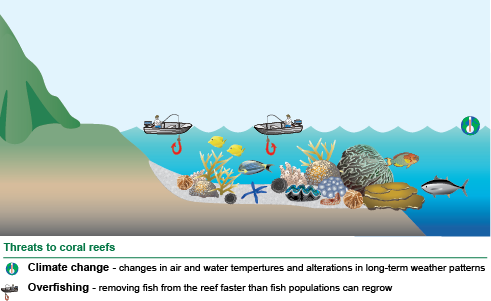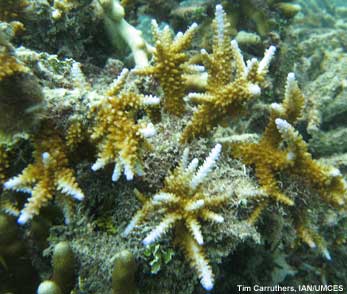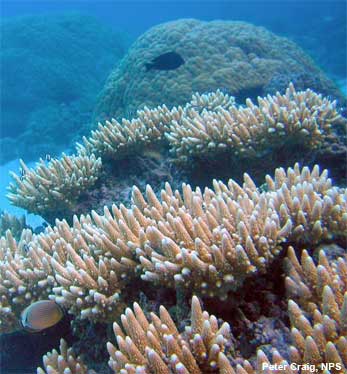Climate change and overfishing are the biggest threats to corals in the National Park of American Samoa
 Through our snorkeler's mask we will see that corals in the National Park of American Samoa are not as healthy as they could be. Impacts from climate change and overfishing are changing the reef—fewer and fewer large reef fish can be seen, and rising sea temperatures will increase the number of bleaching events. Park scientists monitor the reef to observe impacts such as these and to investigate how coral reef health changes over time.
Through our snorkeler's mask we will see that corals in the National Park of American Samoa are not as healthy as they could be. Impacts from climate change and overfishing are changing the reef—fewer and fewer large reef fish can be seen, and rising sea temperatures will increase the number of bleaching events. Park scientists monitor the reef to observe impacts such as these and to investigate how coral reef health changes over time.![]() Climate change leads to decreased corals
Climate change leads to decreased corals
 The impacts of climate change can already be observed on coral reefs in the National Park of American Samoa, and as temperatures rise, we may see even more changes.
The impacts of climate change can already be observed on coral reefs in the National Park of American Samoa, and as temperatures rise, we may see even more changes.Rising air and water temperatures leads to global sea level rise through the melting of the polar ice caps. Increasing carbon dioxide levels in the atmosphere is contributing to ocean acidification. These changes are likely to severely stress and alter coral reefs and the many organisms that depend on a healthy reef.
Coral bleaching is also a concern at the National Park of American Samoa. In 2002 and 2003, increased water temperatures caused extensive bleaching (Craig et al. 2004). In the future, climate change scientists predict that increased ocean temperatures will cause even more coral bleaching to occur in the region (Governor’s Council 2007).
Park staff continue to monitor these impacts and work to educate others about minimizing individual actions which contribute to climate change.
Some reefs in the National Park of American Samoa may be resilient to bleaching
 Across the world, there are places where corals are bleaching due to stress from climate change. Most corals live in waters ranging from 61 – 86°F (16 – 30°C). Yet, in a very few places, some corals survive in water temperatures warmer than most corals can tolerate.
Across the world, there are places where corals are bleaching due to stress from climate change. Most corals live in waters ranging from 61 – 86°F (16 – 30°C). Yet, in a very few places, some corals survive in water temperatures warmer than most corals can tolerate.What is it about these corals and their zooxanthellae that can withstand these extreme conditions? Scientists are trying to answer this question by monitoring corals at Ofu Lagoon located in the National Park of American Samoa, where corals live in waters that occasionally reach 95°F (35°C)—much higher than their normal temperature limit (Craig et al. 2004). For some reason corals in Ofu Lagoon withstand these warmer water temperatures and rarely bleach.
If this unique tolerance to increased water temperatures can be better understood, then scientists could locate and protect hardy (naturally resilient to bleaching) corals and use them to reseed areas where corals have been lost to climate change (Craig et al. 2004). Understanding why these corals can tolerate stressful conditions and what implications this has for the health of corals world-wide is a hot topic being investigated by scientists.
Many organizations including The Climate Change Foundation and The Pacific Islands Climate Change Cooperative are researching ways to better understand and, in some cases combat, global sea temperature rise. For example, by studying a section of the airport reef on Tutuila, American Samoa, Climate Change Foundation scientists discovered that even small decreases in temperature can reverse bleaching (PACN Newsletter 2010). Although artificially cooling a reef is not an ideal way to handle a global problem, it could be a valuable small scale tool for resource managers.
 Overfishing threatens the fish we depend on for food
Overfishing threatens the fish we depend on for food
As modern fishing methods become more and more efficient, greater numbers of fish and other resources such as giant clams are being taken from the reef. If fish are taken faster than the population can reproduce, their numbers decline. This is called overfishing. Today, locals and scientists see fewer and smaller fish on the reefs of American Samoa as a result of overfishing.By respecting the limited resources coral reefs provide, we can ensure that there are fish to eat in the future. We can save what remains in the basket just like a Samoan proverb teaches us....One day, a Samoan family went fishing, leaving one brother at home. They caught many fish and were feasting on the catch when a mother reminded them to save what remained in the basket for their brother, as well as others who might be hungry.
The natural beauty of American Samoa is our basket of fish. If we work together, we can save fish on American Samoan reefs for future generations.
More information:
National Park of American Samoa WebsiteThe Enigma of Ofu Lagoon
Natural History Guide to American Samoa
Marine Benthic Resources
Illustrated fish list
Illustrated coral list
Climate change monitoring briefs
Coral Reefs in U.S. National Parks